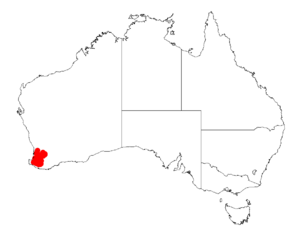Acacia insolita facts for kids
Quick facts for kids Acacia insolita |
|
|---|---|
| Scientific classification | |
| Genus: |
Acacia
|
| Species: |
insolita
|
 |
|
| Occurrence data from AVH | |
Acacia insolita is a special kind of shrub that belongs to the Acacia family. It's found only in the southwestern part of Australia, which means it's endemic there. Think of it as a plant that's a true Aussie native, not found anywhere else naturally!
What it Looks Like
This shrub usually grows to be about 0.1 to 1.2 metres (0.3 to 3.9 ft) tall. Its stems and leaves can be either glabrous (which means smooth and hairless) or a bit hairy.
Near the stems, you'll find small leaf-like parts called stipules, which are about 1 to 4 mm (0.039 to 0.157 in) long. The leaves of this plant are quite interesting because they are bipinnate. This means they are divided into smaller leaflets, much like a feather. These special leaves usually stay on the plant even when it gets older.
Each main leaf part, called a pinna, typically has one pair of smaller leaflets, or pinnules. There can be anywhere from 2 to 12 of these tiny pinnules. They are green and shaped like a spear or a narrow oval, usually 5 to 10 mm (0.20 to 0.39 in) long and 1 to 3 mm (0.039 to 0.118 in) wide.
Sometimes, instead of typical leaves, Acacia insolita has phyllodes. These are flattened leaf stalks that look and act like leaves. They can be 1 to 15 cm (0.39 to 5.91 in) long and 0.5 to 4 mm (0.020 to 0.157 in) wide.
The plant produces pretty yellow-cream flowers from June to September. The flowers grow in simple groups, appearing one by one in the axils (the spot where a leaf joins the stem). These round flower-heads contain 12 to 19 cream to golden-colored flowers.
After the flowers bloom, long, narrow seed pods form. They are about 8 cm (3.1 in) long and 4 to 7 mm (0.16 to 0.28 in) wide. Inside these pods are shiny black to dark brown seeds, each about 3 to 4 mm (0.12 to 0.16 in) long.
How it's Grouped
Scientists have divided Acacia insolita into three different types, called subspecies. These are like slightly different versions of the same plant.
- Acacia insolita subsp. efoliolata
- Acacia insolita subsp. insolita
- Acacia insolita subsp. recurva
Where it Grows
This plant is native to the South West region of Western Australia. You can find it growing on hills and ridges. It prefers sandy soils that contain gravel, often with a type of reddish soil called laterite.
You'll mostly see Acacia insolita along the Darling Range. Its range stretches from around Marradong in the north down to Nannup in the south.

